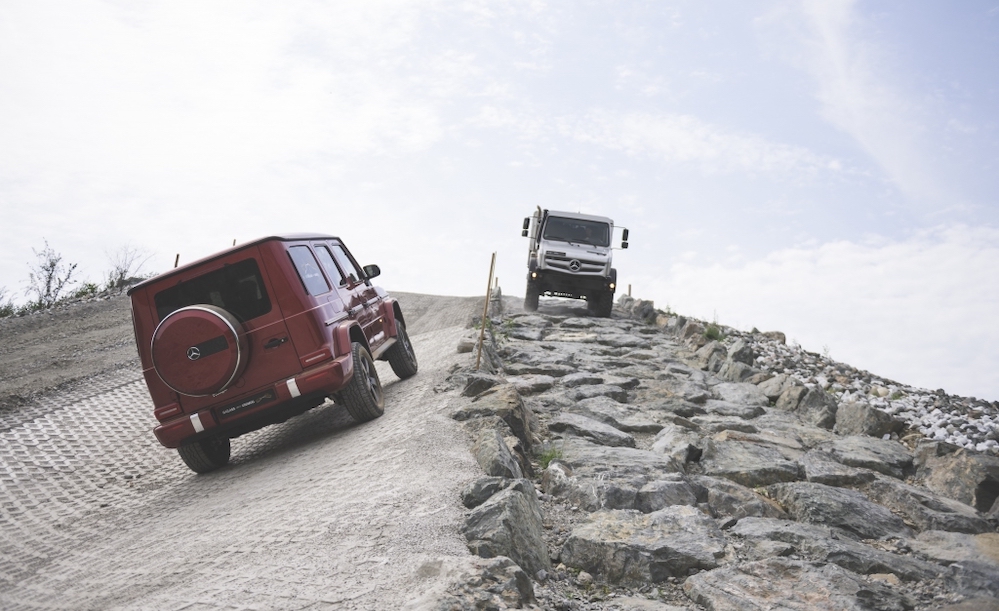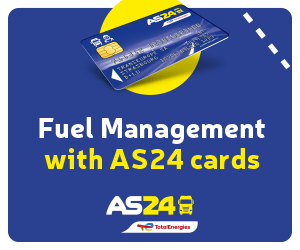UK Haulier witnesses first hand vehicles that rise to top form in extreme terrain in Austria this week. Mercedes-Benz has no less than two of them. What the G-Class is in the passenger car sector, the Unimog is among commercial vehicles. And while the G-Class is celebrating its 40-year anniversary this year, the Unimog can look back on a tradition that spans more than 70 years. Enough reasons to bring both of them together for a summit.
There are vehicles that whet the appetite for adventure and arouse the childlike urge to play in every adult: The Mercedes-Benz G-Class and the Mercedes-Benz Unimog are among them. As unique characters, they both have been taking their very own path for many decades. And this path often starts where others already have reached the end of theirs – thanks to their off-road capabilities. Both of them have already repeatedly demonstrated their reliability and ability to get anywhere at the Dakar Rally and other events. In addition, the Unimog and the G-Class share maximum robustness and durability as well as the tremendous model variety, with which they fulfil virtually any customer request.
“The G-Class has always stayed true to itself over the decades: from the edgy profile to the hallmark noise when the door is clanged shut”, says Peter Schoren, Head of G-Class Product Management and Sales. “At the same time, it has constantly evolved technologically. The current model is the best G-Class of all time in all aspects – regardless of whether we are talking about the comfort, the off-road capabilities or the agility on the road”.
Thanks to its standard ladder-type frame, the 100-percent locking differentials and the LOW RANGE off-road reduction gear, the G-Class gets virtually anywhere. On a suitable surface, its slope climbing ability is up to 100 percent. The G-Class retains its handling stability at bank angles of 35 degrees and with a fording depth of 70 cm even smaller streams can be crossed without difficulties.
In addition to the Unimog implement carrier, which is a familiar sight as an orange municipal vehicle, there are two variants of the Unimog with extreme off-road capabilities: the U 4023 with a gross vehicle weight rating of 10.3 t and the U 5023 with a gross vehicle weight rating of 14.3 t. In each case, the last two digits stand for the output of 231 hp (170 kW), which is produced by a 5.1-litre four-cylinder engine. Low in comparison to the G-Class at first glance. However, for commercial vehicles it is torque that is crucial. And that is where the Unimog delivers an impressive 900 Nm, which are on tap constantly across the entire main operating range of 1200 to 1600 rpm.
This power pack, the selectable all-wheel drive, the on-demand inter-axle and inter-wheel locks as well as eight forward and six reverse speeds with off-road reduction gear make the Unimog the “master off the road”. It conquers gradients of up to 45 degrees or 100 percent. It can tilt by up to 38 degrees, which corresponds to a maximum tilt angle of 76 percent and it has a fording depth of up to 1.20 metres.
Such extreme operations are made possible by, amongst other things, the standard-fit portal axles, which result in an impressive ground clearance of 41 cm. Coil springs with their large spring travel allow an axle articulation of up to 30 degrees. That is why a Unimog can have the left front wheel on top of a rock and the right front wheel in a depression – and still maintain ground contact with all four wheels. Another off-road highlight is the “Tirecontrol plus” tyre pressure control system: The right tyre pressure for the particular surface is selected at the touch of a button (“Road”, “Sand” or “Rough Road”) and the Unimog always has the necessary grip as a result.
These exceptional abilities also make the Unimog interesting as an expedition vehicle. One example is the U 4023 refined by Hellgeth engineering Spezialfahrzeugbau Company. Its gross vehicle weight rating is just 7.49 tonnes.
This is made possible thanks to systematic lightweight construction in building the box body and the cabinetry and by using lightweight aluminium for mounted parts and rims. As a result, the kerb weight including driver and fuel is just 6925 kilograms, making a dream of many globetrotters come true: They can drive a modern Unimog with camper body and extreme off-road capabilities holding the old “Class 3” driving licence.







